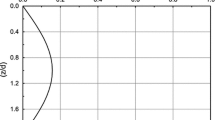Abstract
Barron (Trans ASCE 113:718–724, 1948) theoretical relationship between degree of consolidation (U r ) and time factor (T r ) is generally used to determine the coefficient of radial consolidation c r . Several researchers have proposed different laboratory techniques for obtaining the value of c r . However, the usual approach is to compare some salient features of the theoretical U r –T r relationship with the compression, δ and time, t based on the laboratory data. In this paper, rapid consolidation test procedure originally proposed by Su (J Soil Mech Found Div Am Soc Civ Eng No. 95: Proc. Pap. 1729 (1–9), 1958) to determine the coefficient of vertical consolidation (c v ) is extended to evaluate Barron’s coefficient of radial consolidation c r for the case of equal strain. The characteristic feature of the proposed method is the identification of the steepest tangent from the δ–log t plot. The slope of steepest tangent is independent of the drain spacing ratio (n) with a value of 0.847. This approach is rapid, and it predicts more reliable values of c r as it is less influenced by the secondary compression. In addition, this method is more versatile and can be applied for consolidation trends which do not always exhibit the typical S-shape.



Similar content being viewed by others
References
Barron RA (1948) Consolidation of fine grained soils by drain wells. Trans ASCE 113:718–724
Berry PL, Wilkinson WB (1969) The radial consolidation of clay soils. Geotechnique 19(2):253–284
Casagrande A, Fadum RE (1940) Notes on soil testing for engineering purposes. Harv Soil Mech Ser 8
McKinlay DG (1961) A laboratory study of consolidation in clays with particular reference to conditions of radial porewater drainage. Proceedings fifth international conference on SM & FE, Paris, vol 1, pp 225–228
Olson RE (1986) State of the art: consolidation testing. In: Yong RN, Townsend FC (eds) Consolidation of soils: testing and evaluation, ASTM STP 892. ASTM International, West Conshohocken, pp 7–70
Robinson RG (1997) Determination of radial coefficient of consolidation by the inflection point method. Geotechnique 47(5):1079–1081
Robinson RG (2009) Analysis of radial consolidation test data using log-log method. Geotech Test J 32(2):1–7
Sivaram B, Swamee P (1977) A computational method for consolidation coefficient. Soils Found Tokyo 17(2):48–52
Sridharan A, Prakash K, Asha SR (1996) Consolidation behaviour of clayey soils under radial drainage. Geotech Test J 19(4):421–431
Su HL (1958) Procedure for rapid consolidation test. J Soil Mech Found Div Am Soc Civ Eng no. 95, Proc Pap 1729 (1–9)
Acknowledgments
The authors thank Dr. R G Robinson for the permission to use the laboratory test data for the current analysis.
Author information
Authors and Affiliations
Corresponding author
Rights and permissions
About this article
Cite this article
Vinod, J.S., Sridharan, A. & Indraratna, B. Determination of Coefficient of Radial Consolidation Using Steepest Tangent Fitting Method. Geotech Geol Eng 28, 533–536 (2010). https://doi.org/10.1007/s10706-010-9330-8
Received:
Accepted:
Published:
Issue Date:
DOI: https://doi.org/10.1007/s10706-010-9330-8




